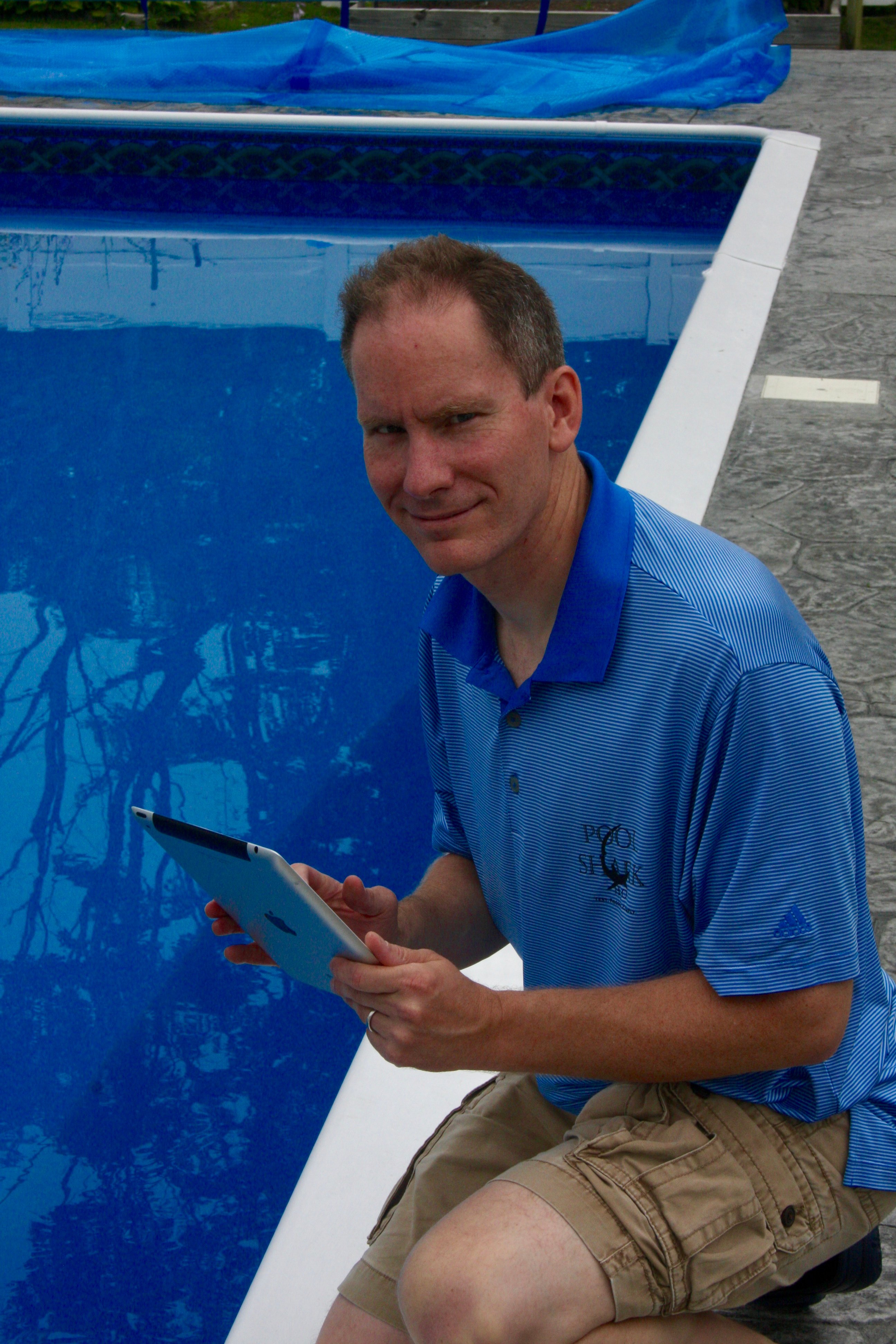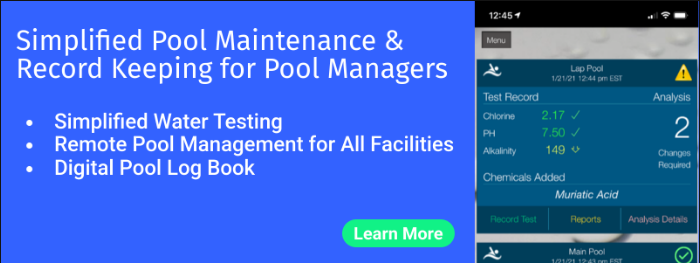Maintaining balanced water chemistry in commercial and public pools isn’t just a best practice—it’s a regulatory and safety necessity. One of the most overlooked yet vital components of water chemistry is pool stabilizer, also known as pool cyanuric acid (CYA). While it plays a crucial role in protecting chlorine from rapid UV degradation, improper levels can create serious problems for public pool operations.

No matter how many or what type of pool you operate, from HOA and apartment pools to hotel pools, public pools, and large aquatic facilities, it’s important to understand why these chemical balances matter so much. It’s also especially helpful if you’re trying to manage a team of employees tasked with testing and maintaining water chemistry; people are far more likely to stay consistent and do a quality job when they understand the “why” behind it. Ahead, we’ll dive into all the reasons to keep your pool stabilizer balanced, as well as some best practices to do so.
Pool Cyanuric Acid Stabilizer Ensures Chlorine Effectiveness
Also referred to as pool conditioner or pool water stabilizer, pool cyanuric acid may be just as critical as chlorine is to your pool’s water quality for outdoor pools. That’s because without it, the chlorine you add would be consumed by the sun in a matter of hours. If you add stabilizer, though, the CYA binds to chlorine molecules, creating a protective layer that prevents them from being prematurely degraded by the sun.
Like all pool chemicals, there’s an ideal range for pool stabilizer levels. While the chlorine will degrade too quickly if the stabilizer is too low, too much is an issue too.
The CDC recommends that all aquatic venues using chlorine and cyanuric acid (CYA) as a pool stabilizer should maintain a minimum DPD Free Chlorine concentration of 2.0 ppm. However, you should also keep CYA stabilizer at or below 40 ppm.
Any higher than that, and the stabilizer binds chlorine too tightly, reducing its ability to disinfect effectively—leaving your pool vulnerable to bacteria, algae, and water-borne illnesses. It can also reduce chlorine’s ability to neutralize contaminants like sweat, urine, and dirt, which can lead to strong chloramine odors, eye and skin irritation, and generally unclean, unsafe water. Maintaining CYA within the optimal range ensures chlorine can sanitize efficiently without causing discomfort for your swimmers or jeopardizing public health.
As it’s also an acid, it can even damage vinyl pool liners when levels are too high.
Pool Cyanuric Acid - Health Department Compliance
Many local and state health departments set strict guidelines for stabilizer levels in public pools, often following the CDC’s Model Aquatic Health Code. Surpassing these limits may result in fines, temporary closures, or failed inspections. In some jurisdictions, stabilizer use in indoor or year-round covered pools is not allowed at all; this is because without the sun the CYA is not needed and will only cause issues. Hot tubs and therapy pools should also not use stabilizer due to the higher temperatures reducing the effectiveness of the chlorine.
Tip: Health codes and regulations change frequently, and vary based on your state and even county. Always check your local public health code to ensure you're compliant with the most recent requirements.
Balanced Pool Cyanuric Acid Stabilizer Prevents Chlorine Overuse and Cost Inefficiency
Low stabilizer levels allows the sun to break down chlorine leading operators to use more than necessary. This not only increases chemical costs but also raises the risk of overcompensation with other additives to maintain balance. However, high stabilizer levels above 40 ppm, reduce the effectiveness of chlorine, requiring a higher concentration of free chlorine in the water to provide the same sanitation results.
Proper stabilization helps reduce chemical consumption, lowering operational costs over time.
Pool Cyanuric Acid Stabilizer Supports Efficient Pool Operation and Maintenance
High stabilizer levels are notoriously difficult to correct. They often require partial draining and refilling, which is costly and time-consuming—especially for larger commercial facilities. Desert climates like Arizona or parts of California also typically have water restrictions that limit frequent pool draining and refilling. Proactive management of CYA helps avoid unnecessary downtime and disruption. Using stabilized chlorine pucks like dichlor and trichlor will continuously increase stabilizer levels over time requiring draining and refilling.
TIP: Using chlorine that does not have CYA stabilizer added, like Cal-hypo or liquid sodium-chloride, and manually adding CYA stabilizer can reduce these issues and save time and money in chemicals and refilling pools.
Pool Cyanuric Acid Stabilizer Best Practices for Commercial and Public Pool Operators
- Test regularly: Use high-quality, accurate pool test kits to monitor CYA at least weekly. We recommend frequent cya testing in outdoor pools even if, based on your visitor volume or location, you’re not technically required to test more than once per month. Testing more frequently makes it easier to keep all water parameters in balance, prevent chlorine lock, and ensure you’re not overusing chemicals.
- Track trends: Maintain records of stabilizer levels and chlorine use to spot rising levels early.
- Avoid overuse of stabilized chlorine products: Products like dichlor and trichlor add CYA with every dose, but unlike chlorine, CYA doesn’t get used up and levels continue to rise as you add more. So while these are convenient and popular especially in warm, sunny climates like Florida and Arizona, it’s doubly critical to track pool stabilizer levels if you’re using these. If you’re using these forms of stabilized chlorine, the best way to manage rising CYA levels is to stop using them when you notice stabilizer levels getting too high. You can either alternate with unstabilized liquid chlorine or Cal-Hypo chlorine, or switch to these types permanently to prevent future stabilizer issues.
However, a word of warning: you should never mix stabilized chlorine (dichlor or trichlor) with unstabilized chlorine; mixed together, they will explode and can cause serious harm or worse! Best practice is to never mix any chemicals together. Chemicals should only be added to water and not the other way around. - In fact, we recommend avoiding stabilized chlorine products altogether: When you add unstabilized chlorine separately from pool stabilizer, it gives you more control over your water balance. This will reduce the frequency you’re adding CYA at and help keep your chemical costs down. Adding it this way means that typically, you’ll only be adding it once at the beginning of the pool season. There may be an occasional exception where you need to add it again during the season, such as following a record swimmer day (like after a summer holiday), a pool party or swim meet, after refilling due to splash out or a large rain, which can dilute water chemical levels.
- Flush or dilute when needed: If levels creep above 80–100 ppm, you’re officially in the danger zone and should plan for partial draining to restore balance.
- Watch other water parameters too: Pool chemistry is complex, with each chemical influencing and interacting with the others differently. Once you have calculated how much to add, ensure the pool’s pH and total alkalinity levels are balanced and within the ideal range too. This will enable the pool’s chemicals, including the CYA you’re adding, to work at their most effective.
Final Thoughts on Pool Cyanuric Acid
For public and commercial pool operators, keeping cyanuric acid in check is critical to maintain clean water and protect your guests, your staff, and your reputation. By maintaining balanced stabilizer levels, you ensure safe, compliant, and cost-effective pool operation—a win for everyone who dives in.
However, even for seasoned pool or facilities pros, this can be tricky to manage. This is especially true if you’re managing multiple pools or still trying to keep accurate records with paper log sheets. Pool Shark H2O does all the complex chemical math dosage equations for you, automatically, and in minutes–while locking pool test results and keeping logs digitally. Archived records help keep your pools 100% Health Department compliant, and make it easy for managers and owners to stay informed on what’s happening with their pool water remotely–including tracking pool stabilizer levels and trends, so you can catch issues before they get out of hand, becoming expensive to remediate. Altogether, this helps ensure safe, balanced water, keeps risks and chemical costs down, and reduces on-site pool visits for management.



